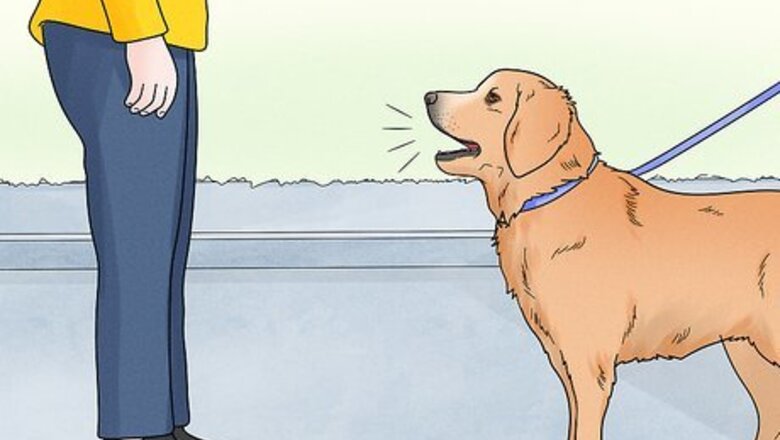
views
Understanding Barking

Observe when your dog barks. Dogs have a wide variety of barks, and they're usually triggered by specific situations. Look for what may be causing the barking behavior when it happens. The following are some common reasons for dogs to bark: Fear/Alarm. When dogs are startled or afraid, they may bark. Nervous dogs tend to bark at any unfamiliar sight or sound, regardless of where they are. Territorial protection. Dogs protect what they perceive as “their” territory. Practically speaking, this could be anywhere that your dog associates with you: your house or yard, the car, or even your “personal space” around your body. Dogs also consider places or routes they travel frequently as their territory, so if you take your dog on the same walk every day, he's likely to consider everything along that route “his.” Attention. Many dogs will bark when they want attention. These barks may be very short and focused. This is especially common if you reward the behavior by responding to the barking. Greeting. Dogs bark to say hello. They may bark at other people or other animals. They also may bark to invite some playtime. Anxiety. Dogs may bark due to separation anxiety. These dogs can't stand being alone and will bark compulsively when they are left on their own. Frustration. Dogs may bark when they're frustrated. If your dog is tied up, can't get at his favorite toy, or wants to go and play with the dog next door, he may bark to signal that he's frustrated with the situation. A dog may also bark if he's bored.
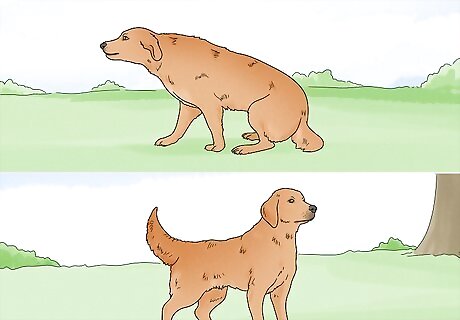
Read your dog's body language. Barking communicates your dog's emotional state. Reading your dog's body language can provide clues as to how your dog feels. For example, if your dog is afraid, she may bark while hunched down. Once you know what's behind the barking, you can help quiet your dog. Here are some signs of your dog's various moods: Afraid. When dogs are afraid, they make themselves smaller to appear as less of a threat. They hunch over, tuck their tails, and flatten their ears to their heads. They may yawn or lick their lips as a way of comforting themselves. Happy. When dogs are happy, their muscles are relaxed. Their mouths are loose and may look like they're smiling. They may pant. Their ears and tail are in the natural positions, and the tail may wag from side to side or in a circular movement. Alert. Dogs go on the alert if they perceive something could be a threat. Their ears are perked up and their gaze will focus on whatever they're looking at. Their tails may be upright or over the back, but they are usually still. The hackles (the fur on the shoulders and upper back) may be raised. Playful. Dogs who are feeling playful are all over the place. They're very energetic, with bouncy movements. They may jump, run in circles, or bow to invite you to play. Playful dogs may look like they're smiling. Dominant. Dogs who feel confident about the interaction display assertive body language. They stand very tall, arch their necks, and appear slightly tense. Their tails are usually upright and still. They may make eye contact. Aggressive. Dogs who feel confident and aggressive about the situation make themselves look bigger by raising their tails, pricking up their ears, and holding their heads high. They may lunge or look ready to pounce. Their lips are often retracted to show the teeth, although sometimes they may pucker their lips forward. Aggressive dogs who are feeling defensive combine fearful and confident body language.
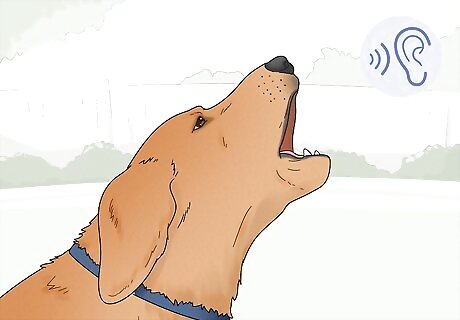
Listen to the tone of your dog's barking. You can tell a lot about a bark by how it sounds. Studies have shown that humans are fairly good at deciphering the overall emotion behind the tone of dog barks. Happy barks are usually high-pitched. Barking as a greeting may also include other noises, such as whines and growls. Barks demanding attention are often short, focused barks. Lower-pitched or harsh-sounding barks usually indicate a disturbance of some kind, like fear or alarm. Separation anxiety barking sounds are often shrill. They sound despairing and miserable. Compulsive barking is often a monotone barking. It sounds repetitive and is often accompanied by movement that seems compulsive.
Removing Reinforcements for the Behavior

Avoid speaking to the dog or giving a hand gesture. These reactions reward the dog with attention and are to be avoided. Shouting is also ineffective. Instead, completely ignore any barking. Telling the dog to be “Quiet” could be counter-effective. In some cases, spritzing your dog's with a spray bottle full of water can be an effective and harmless way to startle her out of barking. However, some dogs see this as a game rather than a distraction, so you'll have to determine whether it works for your dog.
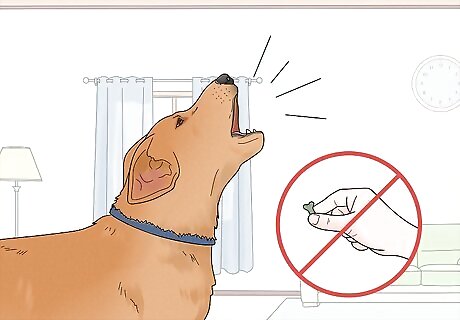
Remove rewards for barking. Rewarding your dog for behaviors you want to eliminate must be avoided, as this will only reinforce those behaviors. For example, if your dog barks at you to get attention and you respond by giving him attention, you've just rewarded him for the action you want to remove! Ignore your dog when he's barking for attention. This can be tough, akin to ignoring a crying baby, but in order to avoid confusing your dog it's important that you not pay him any attention when he's demanding it. Don't reward your dog's demand for attention with glances, pets, or talking. If you're able to, turn your back to him. This will signal that you don't like this behavior. Eventually, the dog will quiet down. When your dog stops barking, praise him and give him treats. As he begins to understand the system, require him to stay quiet for longer periods of time before you reward him.
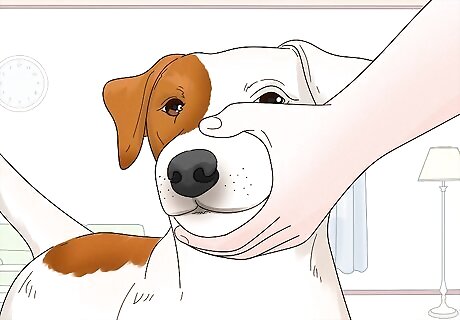
Close your dog's mouth. If your dog is not a nipper, it can be helpful to close your dog's mouth when she barks inappropriately. This is a physical reinforcement that you do not approve of the dog's behavior. There are leashes and halters that allow you to gently pull the mouth closed while you're out on a walk.
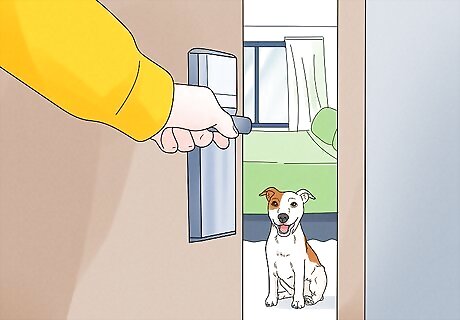
Control the environment. When feasible, remove your dog from anything that triggers barking. Close blinds or curtains if your dog barks at people passing by. Put your dog alone in a room if she barks at guests. Territorial barking can often be addressed by changing what your dog is able to see. Installing a wooden fence instead of a chain link fence or covering your windows with opaque film (that still allows light through) can help a territorial dog quiet down. If your dog startles at unfamiliar noises, play a white noise machine or leave a fan running while you're not home. This can help distract your dog from the other noises she hears.
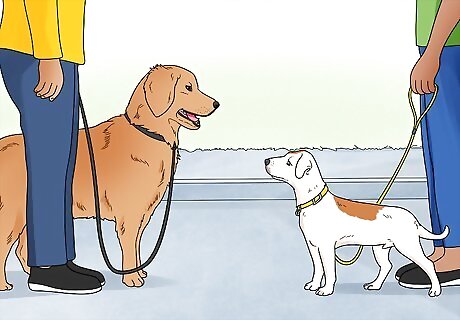
Socialize your dog. If your dog barks whenever she sees other dogs or people, she may not get enough socialization. Model good behavior at the dog park, on walks, and when you interact with people. This can help teach territorial dogs that they don't have to bark to protect their territory everywhere they go. You can also take your dog to “doggie day care,” where she can play with other dogs and learn good dog behavior.
Reinforcing Good Behavior
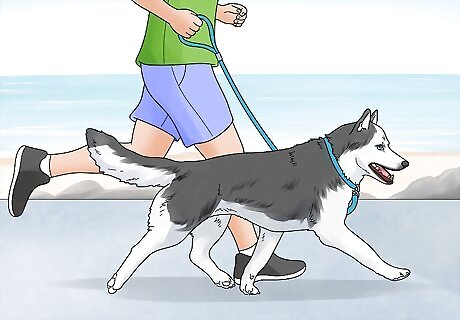
Tire your dog out. Sometimes, dogs bark because they're frustrated or bored. If your dog doesn't get enough exercise, he may bark because he has too much pent-up energy. Give your dog plenty of exercise and playtime to reduce problem barking. If your dog is bored, make sure he has plenty of toys. Puzzle games, especially those that involve food or treats, can be a good way to keep your dog occupied and happy.
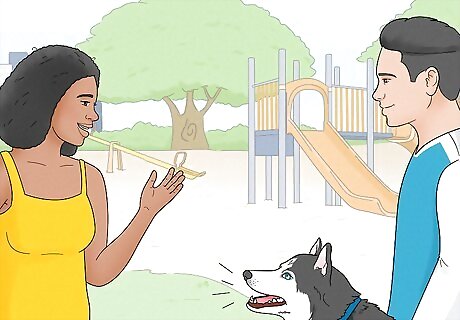
Teach your dog other ways to greet people. Happy dogs may bark to greet others. Teaching your dog other ways to greet them will cut down the problem barking. For visitors to your home, teach your dog to go to a specific spot and wait to receive guests. Get her to sit and stay as you (or a helper) come in the door. Reward her with praise and treats. You can also train your dog to find a special toy near the door when people come over. If he has a toy in his mouth, he's less likely to bark when guests arrive. Train your dog to sit quietly before allowing others to pet him when you're out. This will also reduce the risk that anyone will get hurt by an excited dog. Don't reward greeting barks by acknowledging your dog. Wait until she's quieted down before you greet her and give her pets or treats.
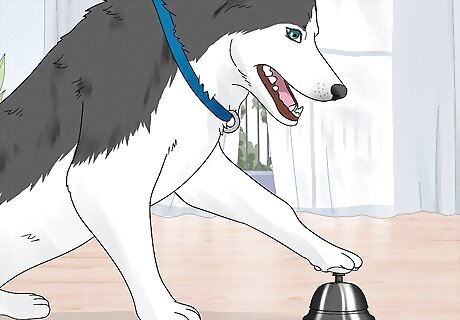
Teach your dog other ways to communicate. Dogs often bark to communicate their needs. If you can train your dog to alert you in other ways, he won't have to bark for everything. For example, ring a bell whenever you take your dog outside to associate the two. Train your dog to ring the bell (hotel-service “tap” bells work very well) when he needs to go outside. Bang the water dish or food dish before you fill it. Your dog will learn to associate the two, and can bang or paw his dish when he's hungry or thirsty.
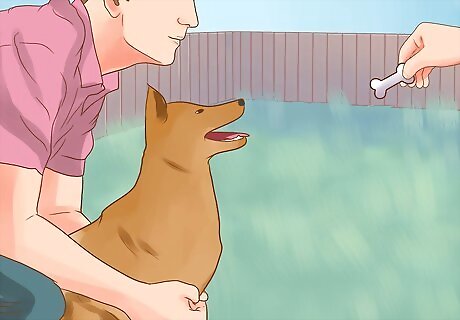
Desensitize your dog. Desensitizing your dog to whatever is causing her barking can help curb problem barking. Start by introducing the stimulus at a distance -- far away enough that your dog doesn't bark at first. For example, if your dog barks at a neighbor's dog, ask if your neighbor will help you. Move the stimulus a little bit at a time toward your dog. Praise her and give her treats for staying quiet. As the stimulus approaches, feed your dog some treats. If she barks, stop the treats. As the stimulus disappears, stop feeding your dog treats. Start small. Gradually increase the time spent around anything or anyone that might make your dog bark. Practice until your dog becomes more and more comfortable. Be patient. Remember: learning any new behavior takes time, practice, and consistency.

Distract your dog. Distracting your dog can help curb problem barking by giving your dog something else to focus on. Once you've distracted the dog, give him something else to do, such as fetch or perform a command. You can use a high-frequency whistle or a noisemaker to break your dog's concentration when he barks. When the dog barks, use the noisemaker. This will interrupt the dog. You can also make a physical noise that isn't verbal, such as clapping or snapping your fingers. Don't yell or shout, though, as your dog will think you're barking with him. Once you have your dog's attention, ask him to perform a task that's incompatible with barking. For example, you could ask him to fetch a toy, go to his crate, or perform a trick.
Teaching Your Dog the “Quiet” Command
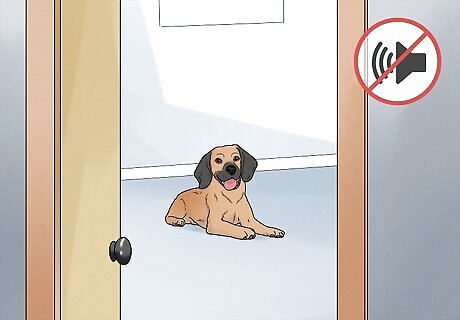
Take your dog to a quiet room. Using a quiet room is the best option for training. Having your dog's full attention will help it learn any new commands.
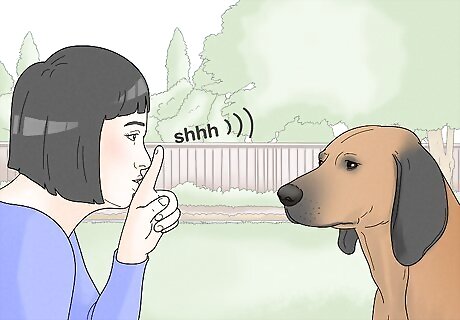
Choose a command to use. Short words that are easy to understand, such as "shh" or "quiet," are helpful. Choose a gesture to help reinforce the command, such as putting your finger to your lips or making a fist. Be consistent and use the command and gesture every time.

Initiate barking. Perhaps counter-intuitively, you need to get your dog to bark to teach her how to be quiet. You could have someone ring the doorbell, or you could rattle a toy that gets her worked up. Allow the dog to bark two or three times. Make a sudden gesture to surprise the dog and stop him barking.
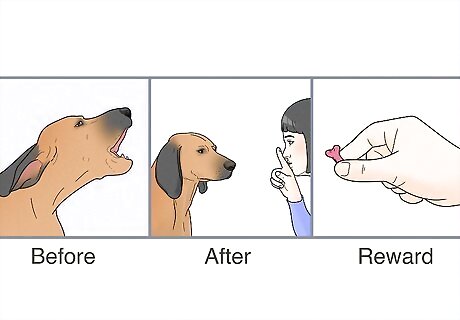
Give the command after the dog is quiet. When training the dog you do not give a command while the dog is barking. Instead, you while he is quiet, you give a food reward and simultaneously give your "Quiet" command. Do not reward the dog until the dog is quiet. It can help to gently close your dog's mouth while you repeat the quiet command.

Keep practicing. Use the quiet command until your dog can be quiet on cue. Remember that it can take some time for your dog to learn new behaviors, so be patient and be consistent! When she stops, pause for a second and then praise her. Give her treats and encourage the silence.



















Comments
0 comment